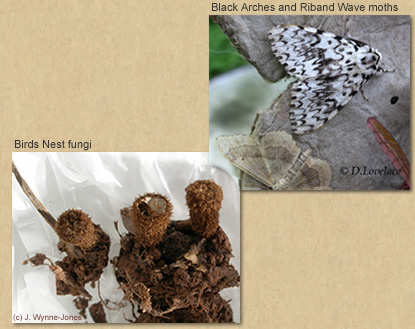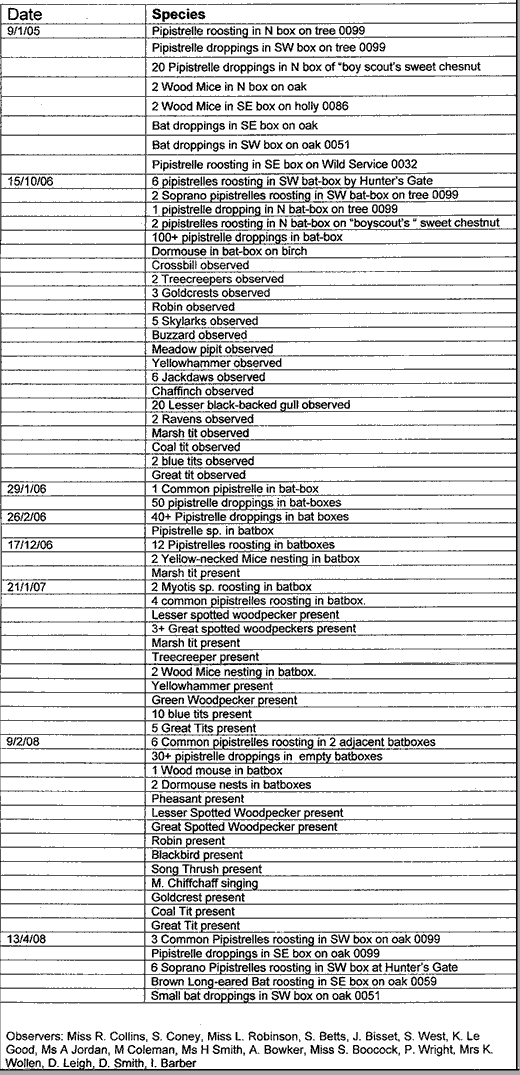

| Species | Common name |
|---|---|
| Acer campestre | Field maple |
| Acer pseudoplatanus | Sycamore |
| Alnus glutinosa | Alder |
| Betula pendula | Siver birch |
| Castanea sativa | Sweet chestnut |
| Cornus sanguinea | Dogwood |
| Corylus avellana | Hazel |
| Cratageus monogyna | Hawthorn |
| Euonymus europeaus | Spindle |
| Fraxinus excelsior | Ash |
| Hedera helix | Ivy |
| Ilex aquifolium | Holly |
| Lonicera periclymenum | Honeysuckle |
| Malus sylvestris | Wilding or Crab apple |
| Populus tremula | Aspen |
| Prunus avium | Wild Cherry or Gean |
| Quercus petraea | Sessile Oak |
| Quercus robor | Pedunculate Oak |
| Rhododendron ponticum | Rhododendron |
| Ribes sylvatica | Flowering currant |
| Rosa arvensis | Field Rose |
| Salix caprea | Goat Willow |
| Salix fragilis | Crack Willow |
| Salix cinerea | Grey Willow |
| Sambucus nigra | Elder |
| Sorbu torminalis | Service tree or chequer tree |
| Taxus baccata | Yew |
| Tilia cordata | Small leaved lime |
| Ulmus glabra | Wych Elm |
| Viburnum opulus | Guelder Rose |
Click a row to search Wikipedia for an entry on the species.
A much studied wood...
Down the years, Ast Wood has had official and unoffical surveys made of many things that live there, and had various studies and reports written about it. There have been ecological and economic surveys; gloomy post-war Forestry Commission assessments; maps of how large tracts of the wood could be obliterated and smoothed and shaped into grass golf course fairways; a late twentieth century overview of the present and future importance of the wood as it is, by a distinguished academic and author on ancient woodland; a twenty-first century 'rapid site identification' survey by a Herefordshire Council archaeologist. There is also a description of the wood on pages 181-3 of The Wild Woods by Peter Marren (David and Charles/NCC 1992).

June 1990 overview of Ast Wood, by Charles Watkins:
Ast Wood is one of the most important surviving areas of ancient semi-natural woodland in eastern Herefordshire. It is about 45 acres in size. Until the early seventies it was bigger, but 20 acres or so of the south western section of the wood were cleared and converted to agricultural land at that time. Most of the remaining woodland is surrounded by a distinct wood bank. This is of particular archaeological interest as many ancient woodlands in Herefordshire do not have distinct wood banks.
The wood is a remarkably attractive and diverse ancient woodland. There are many interesting trees including a very large number of wild service trees. This species of tree is one of the best indicators of ancient woodland. There are also some very large small leaved limes; huge old ash coppice stools; large alder stools along the brooks which rise in the wood; and also oak, yew, aspen, chestnut and cherry.
There is also a very good ground flora with expanses of bluebells and wild daffodils, wood anemone, dog's mercury and wood sorrel. There is a large population of herb paris, a key ancient woodland indicator species. Woodpeckers, both green and spotted are frequently heard and there is an excellent range of characteristic woodland birds such as tree-creepers, chiff-chaff and so forth.
Woodland management records on the nineteenth century show that the wood was regularly coppiced at from twelve to fourteen years' growth. At this time the wood was part of the Eastnor Estate and there is a fine collection of records relating to coppicing and woodland management. The poles were used as hop poles in the local hop yards.
The characteristics of the woodland flora, togther with the setting of the wood and its topography are strong evidence that Ast Wood is primary ancient woodland. Every effort should be made to protect it.
© Charles Watkins, author of Woodland Management and Conservation (David and Charles/NCC 1990); now Professor of Rural Geography, Nottingham University.

